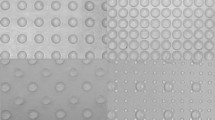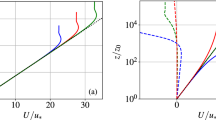Abstract
The geostrophic Ekman boundary layer for large Rossby number (Ro) has been investigated by exploring the role played by the mesolayer (intermediate layer) lying between the traditional inner and outer layers. It is shown that the velocity and Reynolds shear stress components in the inner layer (including the overlap region) are universal relations, explicitly independent of surface roughness. This universality of predictions has been supported by observations from experiment, field and direct numerical simulation (DNS) data for fully smooth, transitionally rough and fully rough surfaces. The maxima of Reynolds shear stresses have been shown to be located in the mesolayer of the Ekman boundary layer, whose scale corresponds to the inverse square root of the friction Rossby number. The composite wall-wake universal relations for geostrophic velocity profiles have been proposed, and the two wake functions of the outer layer have been estimated by an eddy viscosity closure model. The geostrophic drag and cross-isobaric angle predictions yield universal relations, which are also supported by extensive field, laboratory and DNS data. The proposed predictions for the geostrophic drag and the cross-isobaric angle compare well with data for Rossby number Ro ≥ 105. The data show low Rossby number effects for Ro < 105 and higher-order effects due to the mesolayer compare well with the data for Ro ≥ 103.
Similar content being viewed by others
References
Afzal N (1976) Millikan argument at moderately large Reynolds numbers. Phy Fluids 19: 600–602
Afzal N (1982) Fully developed turbulent flow in a pipe: an intermediate layer. Arch Appl Mech (Ingenieur Archiv) 53: 355–377
Afzal N (1984) The mesolayer theory of turbulent flows. AIAA J 22: 437–439
Afzal N (2007) Friction factor directly from transitional roughness in a turbulent pipe flow. J Fluid Eng 129: 1255–1267
Afzal N (2008) Power law universal velocity profile on a transitional rough surface in a turbulent Ekman layer. Q J Roy Meteorol Soc 134: 1113–1125
Afzal N (2009a) Analysis of instantaneous turbulent velocity in geostrophic turbulent Ekman layer on transitional rough surface. In: International Union of Theoretical and Applied Mechanics (IUTAM 2009). Symposium on ‘The physics of wall-bounded turbulent flows on rough walls (Ch: Tim Nickels), July 07–09 2009, Cambridge, UK’, University of Cambridge, Great Britain
Afzal N (2009b) Analysis of instantaneous turbulent velocity vector and temperature profiles in transitional rough channel flow. J Heat Transfer Trans ASME 131:064503-(1–7)
Afzal N, Bush WB (1985) A three layer asymptotic analysis of turbulent channel flows. Indian Acad Sci 53(12): 640–642
Blackadar AK, Tennekes H (1968) Asymptotic similarity in neutral barotropic planetary boundary layers. J Atmos Sci 25: 1015–1022
Caldwell DR, Van Atta CW, Heland KN (1972) A laboratory study of the turbulent Ekman layer. Geophys Fluid Dyn 3: 125–160
Clauser FH (1956) The turbulent boundary layers. Adv Appl Mech 4: 1–51
Coleman GN (1999) Similarity statistics from a direct numerical simulation of the neutrally stratified planetary boundary layer. J Atmos Sci 56: 891–900
Coleman GN, Ferziger JH, Spalart PR (1990) A numerical study of the turbulent Ekman layer. J Fluid Mech 213: 313–348
Csanady GT (1967) On the “resistance law” of a turbulent Ekman layer. J Atmos Sci 24: 467–471
Garratt JR (1994) The atmospheric boundary layer. Cambridge University Press, UK, p 316
Garratt JR, Hess GD (2002) Neutrally stratified boundary layer. In: Bolton JR, Pyle J, Curry J (eds) Encyclopedia of atmospheric sciences. Academic Press, New York, pp 262–271
Freedman FR, Jacobson MZ (2002) Transport-dissipation analytical solutions to the E-e turbulence model and their role in predictions of the neutral ABL. Boundary-Layer Meteorol 102: 117–138
Hess GD, Garratt JR (2002) Evaluating models of the neutral, barotropic planetary boundary layer using integral measures: Part I. Overview. Boundary-Layer Meteorol 104: 333–358
Howroyd GC, Slawson PR (1975) The characteristics of a laboratory produced turbulent Ekman layer. Boundary-Layer Meteorol 8: 201–219
Kung EC (1968) On the momentum exchange between the atmosphere and earth over the northern hemisphere. Mon Weather Rev 96: 337–341
Lin CL, Moeng CH, Sullivan PP, McWilliams JC (1997) The effect of surface roughness on flow structures in a neutrally stratified planetary boundary layer flow. Phys Fluids 9(11): 3235–3249
Long RR (1983) A new theory for rotating boundary layer. Geophys Astrophys Fluid Dyn 28: 27–49
Long RR, Chen TC (1981) Experimental evidence of the existence of the mesolayer in turbulent systems. J Fluid Mech 105: 19–59
Patel VC, Head MR (1969) Some observations on skin friction and velocity profile in fully developed pipe and channel flow. J Fluid Mech 38: 181–201
Raupach MR, Antonia RA, Rajagopalan S (1991) Rough-wall turbulent boundary layer. Adv Appl Mech 44: 1–25
Rosenhead L (1966) Laminar boundary layers. Clarendon Press, Oxford, pp 211–212
Shingai K, Kawamura H (2004) A study of turbulence structure and large-scale motion in the Ekman layer through direct numerical simulations. J Turbul 5:013 (http://jot.iop.org/)
Spalart PR (1989) Theoretical and numerical study of a three-dimensional turbulent boundary layer. J Fluid Mech 205: 319–340
Spalart PR, Coleman GN, Johnstone R (2008) Direct numerical simulation of the Ekman layer: a step in Reynolds number, and cautious support for a log law with a shifted origin. Phys Fluids 20: 101507
Wei T, Fife P, Klewicki J, McMurtry P (2005) Properties of the mean momentum balance in turbulent boundary layer, pipe and channel flows. J Fluid Mech 522: 303–327
Zilitinkevich SS, Esau IN (2005) Resistance and heat/mass transfer laws for neutral and stable planetary boundary layers old theory advanced and re-evaluated. Q J Roy Meteorol Soc 131: 1863–1892
Author information
Authors and Affiliations
Corresponding author
Rights and permissions
About this article
Cite this article
Afzal, N. Neutrally Stratified Turbulent Ekman Boundary Layer: Universal Similarity for a Transitional Rough Surface. Boundary-Layer Meteorol 132, 241–259 (2009). https://doi.org/10.1007/s10546-009-9390-6
Received:
Accepted:
Published:
Issue Date:
DOI: https://doi.org/10.1007/s10546-009-9390-6




